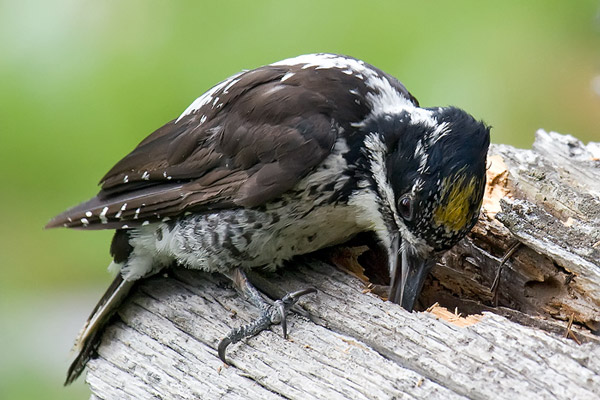|
Utah Bird Profile |
|||||
|
Name Roots: (L. picus, "a woodpecker"; oides, "resembling" - L. dorsum?, "back") |
|||||
| In Utah: |
This rare permanent species is classified as a “sensitive species” in the
Intermountain Region of the U.S. Forest Service, and as a “species of
concern” by the Utah State Division of Wildlife Resources. This means that
the population viability is of concern for whatever reason and is to receive
special consideration when projects may impact its numbers. ~Merrill Webb |
 by Kendall Brown |
|||
| Nesting, feeding, characteristic behaviors: |
Nests in a snag at a height of 3-15 (1-45) feet, in a cavity nest. This
species is not a cowbird host. This species is an insectivore:
bark scaler. |
||||
| Habitat: | Breeds in Utah in sub-alpine conifer
and lodgepole pine habitats. |
||||
| How to find: |
The Three-toed is a challenging bird to locate due to its rather retiring
nature. It prefers burned tracts of forests or conifers (especially spruce)
sick or dead from insect infestation. One of the best indicators of its
presence in a particular area is to look for large patches of bare tree
trunks where the bark has been flaked off. One of the most consistent
localities for finding this woodpecker has been the Uintahs, especially in the Trial Lake and Mirror Lake
areas. Other sites have been the Silver Lake area at Brighton up Big Cottonwood
Canyon, Main Canyon east of Strawberry Reservoir and, in appropriate habitat,
headwaters of the White River northeast of Soldier Summit up Spanish Fork
Canyon. When searching for this species please resist the urge to use taped
calls.
~Merrill Webb |
||||
|
USGS Profile
(Geological Survey) |
US
Winter Range Map |
US
Summer Range Map | |
|||||
|
|||||
|
Abbreviations | References | Legend
|
|||||